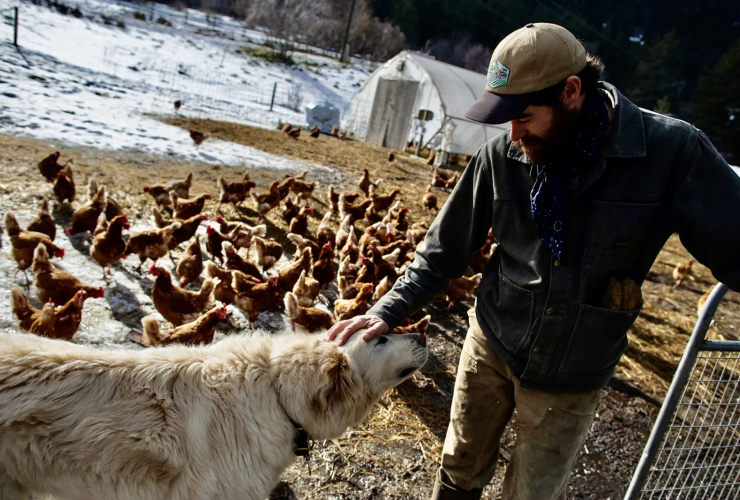By 2030, growing meat cells in vats and cultivating animal proteins using modified micro-organisms could make a $7.5-billion and 86,000 jobs annual contribution to Canada’s economy — about the size of the fishing and seafood industry. In the most optimistic scenario, that contribution could reach $12.5 billion annually in the longer term.
These are the predictions of a report by industry organization Ontario Genomics released in November. The report, the first of its kind in Canada, says cellular agriculture — a catch-all phrase for different processes of cultivating cells to create new foods that can replace animal products — could reduce food’s environmental impact and help feed our growing planet while creating benefits for the Canadian economy.
“This industry can supplement current food supply chains that are really in difficulty,” says Bettina Hamelin, CEO of Ontario Genomics. Her organization and other industry players are calling on the Canadian government to fund research and development in the field and prepare a regulatory pathway for its products to make it to market.
What is cellular agriculture?
Cell ag, as it’s called, is a fledgling industry built on a high-tech vision: With enough research and development, it should be possible to grow animal products for human consumption in scaled-up versions of the bioreactors now used in the pharmaceutical industry to produce drug treatments. Lab-grown meat and dairy — the theory goes — could replace animals in our diet, cutting down on animal suffering, lessening the carbon footprint of meat and lowering our risk of disease from animal agriculture.
By the end of 2021, this vision had attracted more than $2 billion in investment, according to one report — about half of that money in just one year.
The problem cellular agriculture proposes to solve — the need for further animal agriculture in an already overstretched planet — is one of the most pressing of our time. “There’s opportunity for massive climate and environmental gains and also improvement in animal lives,” says Lenore Newman, the director of the Food and Agriculture Institute at the University of the Fraser Valley, who consulted on the Ontario Genomics report.

The report includes consultations with more than 60 stakeholders in industry, academia, the not-for-profit sector and government as well as an economic analysis from University of Guelph food systems expert Mike Von Massow.
“Canada has some natural advantages — geography, training, feedstock, a well-established reputation in food products in the export market,” he says.
The major players in the field are headquartered in the U.S., Israel and Asia, but Canada hasn’t been immune to the cell ag boom: the country’s first active company, Future Fields, was founded in Alberta in 2018. Today, it sells proteins made in gene-edited fruit flies to other cellular agriculture companies and the pharma sector.
Since the mid-2010s, regional and national organizations devoted to the field have risen up and more Canadian researchers have gotten on board with the once science-fiction idea.
Newman sees the field as an inevitable part of the food system, in some form. There are only two choices, she says: “Cellular agriculture is either going to happen in Canada or to Canada.”
The big problem with cultured meat
Following the report, Hamelin says, there are indications that industry took notice. Her organization has seen an uptick in inquiries related to the Canadian landscape, she says. “There is a huge market opportunity.”
But the future isn’t all rosy. The flagship promise of cellular agriculture, lab-grown meat, is still a long way off. Cultured meat’s market prospects are constrained by two major factors: cost and feasibility. In other words, a given product (say, lab-grown chicken nuggets, which are a relatively simple prospect) has to be affordable enough to displace both traditional meat and plant-based alternatives, and also technically possible to produce at scale.
Someone with access to these companies — at conferences or events, or by being linked to them somehow — can sample some cultured meat products from about a dozen companies worldwide. That’s what Lejjy Gafour, CEO of Vancouver-based investment firm CULT Food Science and one of the founders of Canadian cell ag company Future Fields, encourages everybody who has the opportunity to do. “That’s really what seals the deal,” he says.
But there’s nowhere in Canada where you can try lab-grown meat right now. “It is mostly contained to private tasting events or trade shows/conferences,” Gafour told Canada’s National Observer in a follow-up email.

Being able to make small amounts of cultured tissue is nothing new. Making huge amounts is a different story. Scientists have only recently begun contemplating what it would truly take to bring cultured meat to a scale that would notably displace the footprint of traditional meat. The most critical take (for which I provided science communication consulting services) is from an American consulting engineer named David Humbird, whose work was funded by the Silicon Valley-backed funder Open Philanthropy.
Humbird’s assessment suggests that producing cultured meat at scale isn’t physically possible without a number of other significant technological and cost-related leaps in cellular engineering and in the production of the materials that cells need to grow. It was “hard to find an angle that wasn’t a ludicrous dead end,” he told reporter Joe Fassler in 2021.
The problems are daunting. The cells of living organisms are evolved to live as part of a body — a system composed of networks of different kinds of cells that perform many functions co-operatively. Meat cells grown outside that system need the same level of care — waste cycling, nutrients, heat controls, defence from predatory microbes. All of those functions need to be designed into cultured meat manufacturing systems.
The Good Food Institute (GFI), a philanthropist-funded protein innovation non-profit, produced an analysis last fall that counters Humbird’s assessment. It suggests cultured meat could be a cost-competitive player on the market by 2030 — the same date posited by Ontario Genomics. GFI, writes Fassler, needs this hopeful finding to keep the industry alive: “If private, philanthropic, and public sector investors are going to put money into cell-cultured meat, costs need to come down quickly.”
Neither of these assessments, known as techno-economic analyses, are cited in the Ontario Genomics report, though it does call for techno-economic analysis to be done “on a product-by-product basis.”
Asked about these limitations, Hamelin points to Israeli company Future Meat, which raised US$347 million in Series B funding last year after opening what it called the first cultured meat production facility at its headquarters in Rehovot. That facility, it says, has the capacity to produce about 500 kilograms a day of cultured chicken. However, it’s not known if the facility has ever been put through its paces — something that, due to the intensive cleanliness needs of cell culture, would be a massive and expensive effort. At press time, Future Meat had not responded to Canada’s National Observer’s request for comment.
The company has said it will build a larger facility in the United States with its new cash. It is still waiting for regulatory approval for its products in both the U.S. and Israel, although Israeli diners can access its wares at a small test restaurant.
A few other companies, including Wildtype Foods, Upside Foods and Aleph Farms, have also built pilot facilities in the U.S. and Israel. The next big step for these companies: getting the government OK. Presently, the only place that has granted regulatory approval for cultured meat is Singapore, where cultured chicken bites produced by the company Eat Just are available to order from one restaurant. “When you look at how quickly this has evolved over the past five to eight years, this is tremendous progress,” Hamelin says.

Lab-grown dairy
Cellular agriculture has prospects beyond lab-grown flesh, however. Precision fermentation offers a more immediately accessible future.
Perfect Day, a U.S.-based alt dairy company, has actually hit the American market, sending its valuation skyrocketing and prompting collaborations with established brands like candybar-maker Mars. Its technology uses genetically modified fungi to convert sugars into milk protein without the need for cows. “Precision fermentation of dairy proteins continues to outperform what even we expected,” says Newman.
Precision fermentation has been used since the early 1990s to produce rennet, an ingredient essential for cheese-making. It’s also what’s behind the meaty heme found in Impossible Burgers. Because the products in question are liquid, not cells, precision fermenting presents easier-to-solve understood problems than cultured meat cells, which are meant to grow inside an organism.
Newman, like some of her colleagues, says Canada is well-positioned to make more advances in the field. Our twin superpowers: the ability to produce massive amounts of starch (needed to feed the micro-organisms so they can make protein) and a homegrown industry that deals with huge volumes of liquid. “We have an entire oil industry that builds the kind of infrastructure these companies need,” she says.
New industries tend to be volatile, which makes forward-looking predictions difficult. “This is not a guarantee,” says Von Massow of his financial predictions in the Ontario Genomics report. “There is some uncertainty here.” Newman says the report’s numbers are “realistic with the proviso that this is an extremely uncertain technology platform.” Gafour is similarly hedgy: “I think those numbers are achievable if we focus on it, but that’s always the hard part,” he says.
Leaving aside technical challenges, the cost of cellular agriculture gives Sarah Duignan, a human environment consultant with a PhD in food and cultural health, pause. In early 2020, she wrote an essay for The Conversation expressing concern that focusing on lab-grown meat could leave the most food-insecure people vulnerable. Cellular agriculture products, especially meat, are unlikely to be cost-competitive — and what’s more, consumer acceptance remains an open question. “For lab-grown meat to work, it can’t be the sole solution to reducing our traditional meat consumption,” she says.
Other solutions do exist. “In a way, we’re solving a problem that plant-based does quite nicely,” says Newman. Still, like Duignan, she feels that a multiplicity of options needs to be available in the transition away from animal agriculture.
Technical innovations can play an important role in addressing food insecurity, says Brady Deaton, an agricultural economist at the University of Guelph who has been studying that issue as it pertains to COVID-19. But it’s hard to evaluate any specific technology before you see it in action, he says: “Really, the rubber hits the road in the assessment by specifics.”
Updates and corrections
| Corrections policyThis story was corrected to reflect that Future Fields was founded in 2018.
Animals grown for meat live a
Animals grown for meat live a relatively normal life, although a short one, but animals raised for milk are, in my view, mistreated, even if well fed, bedded and cared for. To be a cow carrying a huge udder that interferes with her legs, to have few if any opportunity to see the sun and run in the field, to be pregnant each year, with limited opportunity to exercise her maternal instincts, that is animal cruelty!
The article says that it is possible to animal milk in the factory, but a superior solution is plant-based milk alternative, such as Silk. The advantage of plant-based "milk" is that is relatively simple mixture of natural ingredients and is already a proven alternative to methane-burping cows. Of course, growing oats, coconut, soy and sunflower intensively to produce such "milk" is not without environmental impacts, but at least animals do not suffer.
Yeahhh . . . but, plant-based
Yeahhh . . . but, plant-based milk sucks. I've tried a few kinds, they're lousy. If real milk stopped existing I'd just drink fruit juice. What's the point of making perfectly respectable stuff like oats or soy pretend badly to be milk? It's undignified.
It's like soy-based "meat"--I like tofu fine, marinate it in some nice sauces and put it in a stir fry or whatever, AS TOFU, and it's great. As meat, it sucks. Just let it be tofu.
As to how well animals grown for meat live vs. dairy cows--I don't think feedlots represent "a relatively normal life", and I've never seen any indication that dairy cows under your more old fashioned, not-so-factory, end of care are unhappy with their situation. Yes, it's weird and unnatural, but that doesn't mean they don't like it. My life is weird and unnatural--I wear clothes, type things into computers, have central heating etc., but I'm quite pleased with most (not all, but most) of the weird unnatural features involved.
I've tried Slik (2% fat) and
I've tried Slik (2% fat) and loved it. The main difference between Silk and regular 2% milk is that you have to shake the carton well before you pour. It is distributed by Danone Canada, but, unfortunately, it is made in USA.
Try it before you criticize it!
Ms. Eschner, if these
Ms. Eschner, if these cultured meat products become available in stores, will you personally buy them, take them home, and eat them?
The whole cell-culture meat
The whole cell-culture meat production thing is kind of bizarre. On one hand, IF the stuff could be made cheaply, at scale, in an environmentally friendly way, and fairly well, then that could be kind of good. But I don't know that any of those things are all that likely. "Because it's a technology" is not a good enough reason; organisms have been evolving for hundreds of millions of years to be effective at making more of themselves. I would expect it to take a fair amount of work to get better at it than they are.
And making meat is not as simple as just culturing some muscle cells. Gotta be marbled with fat, gotta have something like muscle tone, gotta be three dimensional, if it's three dimensional it's gotta have oxygen supply to the middle, which probably means some kind of blood supply system, capillaries . . . it's quite elaborate tissue, which will require quite elaborate, probably expensive, technology.
Unless you're just making chicken nuggets. Hard to tell if the stuff in those is actually meat anyway, stacks of sheets of muscle cells would probably do fine.
It's too bad that the
It's too bad that the _National Observer_ doesn't provide a means of voting on comments, because I would definitely up-vote this one. For the comment about chicken nuggets alone. I feel the same way about McDonald's burgers.
When I thought about this whole idea, I came up with, if you could synthesize milk, you could make cheese from it, which would then make it possible to make pizza that didn't contain animal products. BUT, how would you go about making emmental cheese? Or gruyere, cambozola, or chester? The answer is, you don't.






Comments